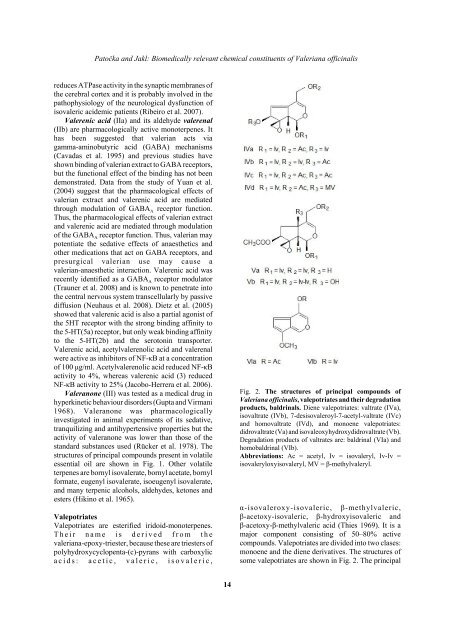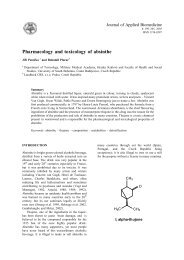Biomedically relevant chemical constituents of Valeriana officinalis
Biomedically relevant chemical constituents of Valeriana officinalis
Biomedically relevant chemical constituents of Valeriana officinalis
You also want an ePaper? Increase the reach of your titles
YUMPU automatically turns print PDFs into web optimized ePapers that Google loves.
Patočka and Jakl: <strong>Biomedically</strong> <strong>relevant</strong> <strong>chemical</strong> <strong>constituents</strong> <strong>of</strong> <strong>Valeriana</strong> <strong>of</strong>ficinalis<br />
reduces ATPase activity in the synaptic membranes <strong>of</strong><br />
the cerebral cortex and it is probably involved in the<br />
pathophysiology <strong>of</strong> the neurological dysfunction <strong>of</strong><br />
isovaleric acidemic patients (Ribeiro et al. 2007).<br />
Valerenic acid (IIa) and its aldehyde valerenal<br />
(IIb) are pharmacologically active monoterpenes. It<br />
has been suggested that valerian acts via<br />
gamma-aminobutyric acid (GABA) mechanisms<br />
(Cavadas et al. 1995) and previous studies have<br />
shown binding <strong>of</strong> valerian extract to GABA receptors,<br />
but the functional effect <strong>of</strong> the binding has not been<br />
demonstrated. Data from the study <strong>of</strong> Yuan et al.<br />
(2004) suggest that the pharmacological effects <strong>of</strong><br />
valerian extract and valerenic acid are mediated<br />
through modulation <strong>of</strong> GABA A receptor function.<br />
Thus, the pharmacological effects <strong>of</strong> valerian extract<br />
and valerenic acid are mediated through modulation<br />
<strong>of</strong> the GABA A receptor function. Thus, valerian may<br />
potentiate the sedative effects <strong>of</strong> anaesthetics and<br />
other medications that act on GABA receptors, and<br />
presurgical valerian use may cause a<br />
valerian-anaesthetic interaction. Valerenic acid was<br />
recently identified as a GABA A receptor modulator<br />
(Trauner et al. 2008) and is known to penetrate into<br />
the central nervous system transcellularly by passive<br />
diffusion (Neuhaus et al. 2008). Dietz et al. (2005)<br />
showed that valerenic acid is also a partial agonist <strong>of</strong><br />
the 5HT receptor with the strong binding affinity to<br />
the 5-HT(5a) receptor, but only weak binding affinity<br />
to the 5-HT(2b) and the serotonin transporter.<br />
Valerenic acid, acetylvalerenolic acid and valerenal<br />
were active as inhibitors <strong>of</strong> NF-κB at a concentration<br />
<strong>of</strong> 100 μg/ml. Acetylvalerenolic acid reduced NF-κB<br />
activity to 4%, whereas valerenic acid (3) reduced<br />
NF-κB activity to 25% (Jacobo-Herrera et al. 2006).<br />
Valeranone (III) was tested as a medical drug in<br />
hyperkinetic behaviour disorders (Gupta and Virmani<br />
1968). Valeranone was pharmacologically<br />
investigated in animal experiments <strong>of</strong> its sedative,<br />
tranquilizing and antihypertensive properties but the<br />
activity <strong>of</strong> valeranone was lower than those <strong>of</strong> the<br />
standard substances used (Rücker et al. 1978). The<br />
structures <strong>of</strong> principal compounds present in volatile<br />
essential oil are shown in Fig. 1. Other volatile<br />
terpenes are bornyl isovalerate, bornyl acetate, bornyl<br />
formate, eugenyl isovalerate, isoeugenyl isovalerate,<br />
and many terpenic alcohols, aldehydes, ketones and<br />
esters (Hikino et al. 1965).<br />
Valepotriates<br />
Valepotriates are esterified iridoid-monoterpenes.<br />
Their name is derived from the<br />
valeriana-epoxy-triester, because these are triesters <strong>of</strong><br />
polyhydroxycyclopenta-(c)-pyrans with carboxylic<br />
acids: acetic, valeric, isovaleric,<br />
14<br />
Fig. 2. The structures <strong>of</strong> principal compounds <strong>of</strong><br />
<strong>Valeriana</strong> <strong>of</strong>ficinalis, valepotriates and their degradation<br />
products, baldrinals. Diene valepotriates: valtrate (IVa),<br />
isovaltrate (IVb), 7-desisovaleroyl-7-acetyl-valtrate (IVc)<br />
and homovaltrate (IVd), and monoene valepotriates:<br />
didrovaltrate (Va) and isovaleoxyhydroxydidrovaltrate (Vb).<br />
Degradation products <strong>of</strong> valtrates are: baldrinal (VIa) and<br />
homobaldrinal (VIb).<br />
Abbreviations: Ac = acetyl, Iv = isovaleryl, Iv-Iv =<br />
isovaleryloxyisovaleryl, MV = β-methylvaleryl.<br />
α-isovaleroxy-isovaleric, β-methylvaleric,<br />
β-acetoxy-isovaleric, β-hydroxyisovaleric and<br />
β-acetoxy-β-methylvaleric acid (Thies 1969). It is a<br />
major component consisting <strong>of</strong> 50–80% active<br />
compounds. Valepotriates are divided into two clases:<br />
monoene and the diene derivatives. The structures <strong>of</strong><br />
some valepotriates are shown in Fig. 2. The principal





